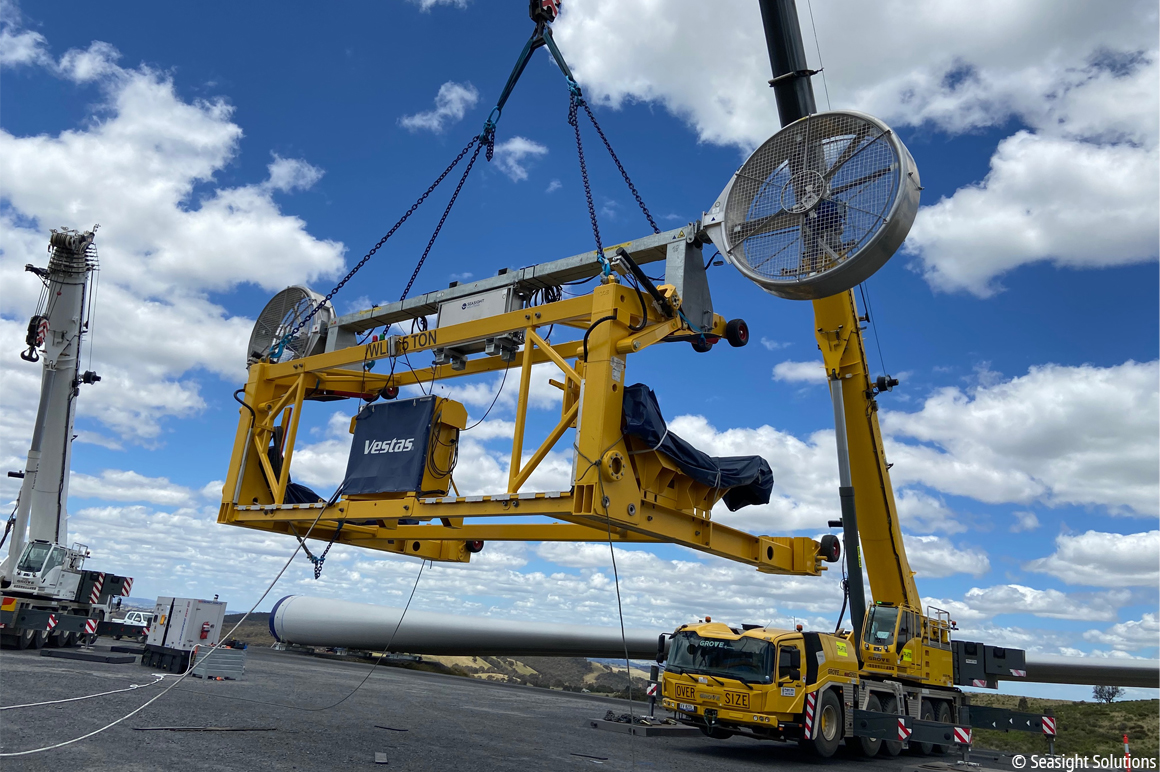

PC-based control for the installation of wind turbines in any weather
According to Danish company Seasight Solutions, the entire industry is talking about a real game changer in the field of wind-turbine installation. This innovative new approach uses human-sized propellers to compensate for wind loads and keep the rotor blades precisely in position in relation to the hub, allowing the huge components to be assembled safely and quickly without hauling ropes – even on stormy days. However, a sophisticated control concept and real-time-capable automation technology are needed to make this possible, which is precisely where PC-based control from Beckhoff comes into play.
Wind turbines are getting taller, rotor blades are getting longer, and the number of turbines being installed is increasing. With this in mind, it goes without saying that fast and safe installation is essential, no matter from which direction or how strong the wind blows, or whether the wind turbines are to be installed near a lake or in the middle of a forest. “Today’s rotor blades are mainly still stabilized with the taglines used to lift them up perpendicular to the ground,” explains Mads Susgaard, Head of Automation Technology at Hvide Sande Shipyard A/S in Denmark. The problem is that traditional installation aids are difficult to use at sites like this, plus the potential for bad weather often wreaks havoc with scheduling.

Seasight Solutions A/S, a spin-off of Hvide Sande Shipyard, has now resolved these problems with its autonomous positioning system (APS), which was developed together with the wind turbine manufacturer Vestas Wind System A/S. “We use propellers to stabilize the momentum of the blades, ensuring safe lifting and stable positioning,” emphasizes Mads Susgaard.
Maximum positioning precision for rotor blades
No matter how cold or hot it is, whether a storm is raging, or what the terrain is like where the rotor blades are to be raised to the nacelle, the APS stabilizes them virtually on autopilot and with defined switch-on and switch-off points. “You would normally expect to use custom electronics for this task,” notes the automation expert, “but with TwinCAT and PC-based control, we have flexibility and can change the software at lightning speed as required.” The control continuously logs all data, which the control system then uses for navigation. The result is impressive: even at wind speeds of up to 14 m/s (wind force 6), the rotor blade is stable and precise in the wind. This makes the crane the limiting factor; the crane safety limit is usually 12 m/s. This also increases the number of possible working days by up to 50 percent, since poor visibility and excessive wind no longer present obstacles. “This means huge time and cost savings for wind energy companies,” enthuses Mads Susgaard, pointing out the enormous benefits of the APS.
The patented system has been tested with 85-meter-long rotor blades, but it can also be scaled to blades measuring just over 100 meters. The solution has also been tested in tough terrain in northern Norway and northern Finland, where the cold conditions and topology of the terrain present real installation challenges. In the meantime, well over 1,000 components have been hoisted into place at their locations and assembled using the APS.
Flexible and high-performance with PC-based control
From the propeller to the software, Seasight Solutions manufactures everything in-house and counts on Beckhoff automation technology. Powerful industrial PCs and TwinCAT software are at the heart of this solution, ensuring crucial accuracy and stability. This is because a high level of computing and processing power are required to calculate the position of the rotor blades at lightning speed and to take corrective action via the propellers or their motor speed. “The impressive thing about the control system is that the PLC estimates the position of the APS in real time,” explains Mads Susgaard. At a frequency of over 1 kHz, to be precise. The speeds of the propellers are controlled on the basis of these scans. According to Mads Susgaard: “When we made the first prototypes, we were set no limits in terms of performance in order to obtain the short cycle times needed for position control.” Ultra-compact industrial PCs, such as the C6015, have emerged as optimal computers.

For current and future automation tasks, standardized, user-friendly software is vital for Seasight Solutions. “TwinCAT is our software of choice for programming and real-time control. When our customers order a customized, high-tech solution from us, this also includes our commitment to monitor performance and continuously optimize it continuously within the framework of multi-year cooperation agreements,” declares the automation expert. This requires 24/7 support via regional service partners and reliable remote maintenance. After all, wind turbines are often installed in locations which are far from the nearest service base. “To ensure that the APS not only works, but also helps operators meet their tight schedules and avoid costly delays, robust diagnostic software and connectivity to both the support center in Denmark and the various service teams are needed,” says Mads Susgaard.
To date, the company has 25 APSs in operation worldwide – in Europe, the USA, Australia, Africa, and Vietnam. The goal is to sell 50 units per year. Plenty of other industries stand to benefit from this solution, too, as the APS can also hold lifting containers, construction elements, and precast concrete parts precisely in position. “We have huge expectations for the APS – both locally and globally, and both within the wind industry and beyond,” concludes Mads Susgaard.